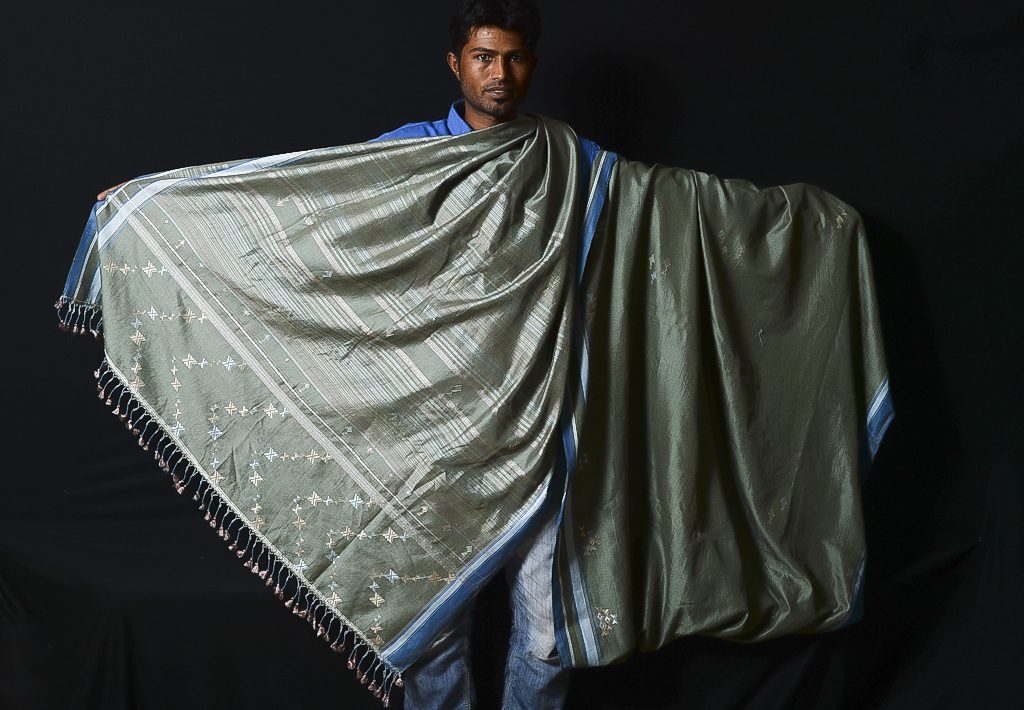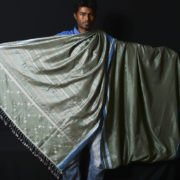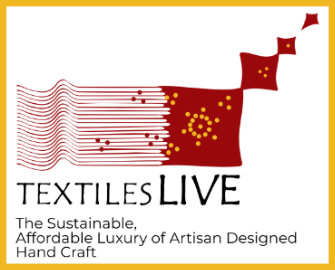Years ago when I was researching Rabari textile traditions, I noticed that when Rabari women made applique quilts they always used new fabric. It seemed odd in a culture in which every resource, everything material, was consciously considered and carefully conserved. Then I realized the perfect economy of their garment construction. There was absolutely no fabric waste to conserve. So for ceremonial quilts, reserved to honour guests, they purchased cloth. But for everyday, Rabari families used quilts that were in fact practically patched from old garments and amazing aesthetic sensibilities.
 All of these practices of Rabari women were governed by awareness and value. They knew the value of the fabrics of their lives. They cut the wool from their sheep, spun it by hand, walked the yarns over to the neighboring weaver, and when the shawls were woven and hand dyed, they collected them, stitched them together and decorated them with hand embroidery. Therefore they conserved them. And when the fabrics wore beyond several re-purposings and any possible further use, the Rabaris respectfully gave them to the sea.
All of these practices of Rabari women were governed by awareness and value. They knew the value of the fabrics of their lives. They cut the wool from their sheep, spun it by hand, walked the yarns over to the neighboring weaver, and when the shawls were woven and hand dyed, they collected them, stitched them together and decorated them with hand embroidery. Therefore they conserved them. And when the fabrics wore beyond several re-purposings and any possible further use, the Rabaris respectfully gave them to the sea.
Dorothy Burnham in her classic book, Cut My Cote, writes of the relationship between the cut of traditional garments and looms. “With today’s ease of manufacture we take textiles for granted and the wasting of cloth does not worry us. But for those closer to the processes of production the attitude changes, and an extreme economy of material was practiced in the cutting of traditional garments. …Full benefit was obtained from it and nothing was left over.”
Contemporary India views tradition through the lens of the industrial model.
Although machines have taken over the work of essential, hand made traditions continue to be considered in terms of productivity, and fixation on productivity has led society to perceive artisans as under-productive, poor guys needing a hand. Government policies view craft as languishing, and subsidize handloom artisans to produce plain white cotton-polyester sheets for the Indian Railways, and yardage for children’s school uniforms, while higher value products such as saris and dupattas are woven in volume by power looms.
Clearly, the sustainable practices and creative capacity of craft are grossly under-valued.
But elsewhere, a hopeful change in psychological climate is happening. People are speaking of a creative economy and cultural consumption. Damage to the environment, and financial recession have forced people to re-think their values. Consumer demand has shifted towards value-centered products that meet emotional as well as functional needs. People are buying hand made as a unique and also ethical route for consuming objects. They consider buying the unique as an experience, and a new way of signaling connoisseurship.
On Black Friday, November 25, 2011 Patagonia, a popular outdoor clothing and gear company, launched an astonishing campaign, “Don’t Buy this Jacket.” “It’s time for us as a company to address the issue of consumerism and do it head on,” the spokesperson said. “The most challenging, and important, element of the Common Threads Initiative is this: to lighten our environmental footprint. Everyone needs to consume less.”
Less product, more value: Cultural consumption.
This is the original model of the Rabari women. Vishramji Valji, a master weaver in a Rabari village in Kutch describes it eloquently, “Rabaris were our fixed clients and we had a personal connection. The feeling of the weaver, in the time of our ancestors, was that he would weave for the one who would wear his work, wanting to make it good, strong, so that as the weaving was used and until it wore away the owner would remember the artisan’s name.”
This is the essence of traditional craft.
Cloth was woven as a part-time occupation, in lulls of the agricultural cycle. Production was close to customized, and fabric lasted, was valued, and up-cycled before the term was coined. Artisans did not need to produce so much.
Traditional production was not faster, cheaper and more standard; it was slow, valuable and infinitely rich with character.
In the current issue of Selvedge magazine, Lucy Siegle writes on “The True Cost of Fashion.”
Traditions can demonstrate an alternative. Value will genuinely guide us from rampant consumerism to sustainable, cultural consumption.
The education for artisans program with which I have been working for a decade seeks to change the perception of the value of the artisan and the hand made, to increase value rather than volume, and improve the quality of life for people and planet.
Today, young artisans about to graduate reflected on their year of design education.
Aslam Abdul Karim Khatri, “As a production printer, I saw my craft as “roji-roti.” But in learning design, I realized that the tradition is far more important. It is our heritage and we need to value and maintain it.”
Pachan Premji Siju, “I already wove for a living. What I have now done with my weaving is what is important. I realized the value of one good piece compared to yards of production.”


